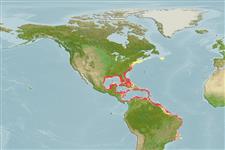Classificação / Names
Common names from other countries
Referência principal
Tamanho / Peso / Idade
Max length : 184 cm TL macho/indeterminado; (Ref. 9710); common length : 70.0 cm FL macho/indeterminado; (Ref. 168); Peso máx. publicado: 45.0 kg (Ref. 168); Idade máx. registada: 14 anos (Ref. 4949)
Length at first maturity
Lm 63.3, range 45 - 114 cm
Ambiente
; marinhas associadas(os) a recifes; oceanódromo (Ref. 51243); intervalo de profundidade 5 - 140 m (Ref. 36484), usually 5 - 15 m (Ref. 40849)
Clima / Intervalo
Tropical, preferred 23°C (Ref. 107945); 44°N - 22°S, 98°W - 34°W (Ref. 54879)
Distribuição
Descrição breve
Espinhos dorsais (total): 12 - 18; Raios dorsais moles (total): 15-18; Espinhos anais 0; Raios anais moles: 16 - 20; Vértebras: 41 - 43. Interpelvic process small and bifid. Swim bladder absent. Lateral line abruptly curving downward below second dorsal fin. Intestine with 2 folds and 3 limbs. Adults have no black area on the anterior part of the first dorsal fin. Juveniles with bronze spots in 5 or 6 irregular rows. Body entirely covered with scales.
Categoria na Lista Vermelha da IUCN (Ref. 115185)
Ameaça para o homem
Reports of ciguatera poisoning (Ref. 9710)
Utilização humana
Pescarias: espécies comerciais; peixe desportivo: sim
Ferramentas
Relatórios especiais
Descarregue XML
Fontes da internet
Estimates of some properties based on models
Phylogenetic diversity index
PD50 = 0.5000 many relatives (e.g. carps) 0.5 - 2.0 few relatives (e.g. lungfishes)
Nível Trófico
4.4 ±0.3 se; Based on diet studies.
Resiliência
Baixo, tempo mínimo de duplicação da população 4,5 - 14 anos (K=0.07-0.15; tm=2; tmax=14; Fec=70,000)
Vulnerabilidade
High vulnerability (58 of 100)
Categoria de preço
